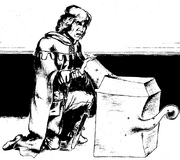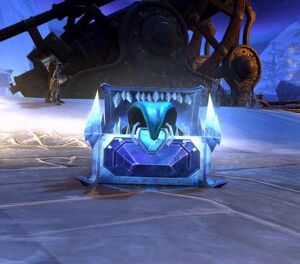Mimics were strange predators that assumed the form of mundane furnishings and household objects in order to attract prey.[1]
Description[]
Mimics occupied a volume of approximately 15 cubic feet (0.42 cubic meters). They could assume any shape, provided that they retained the same volume.[5] In order to most effectively lure adventurers, they most commonly took the shape of doors, chests, and other objects likely to be touched. Their skin texture and color could change to almost perfectly resemble wood, stone, metal, and other basic materials.[1][5] Though the natural state of a mimic's skin was a rough speckled grey similar to granite.[5][7]
Behavior[]
Mimics had no concerns beyond surviving and acquiring food. Although some intelligent varieties of mimics were capable of basic communication, they had no culture, no moral code, and no interest in religion. More aggressive mimics could not be reasoned with in any capacity.[5]
Abilities[]
Mimics were capable of altering the pigmentation and texture of their skins by pumping a brown pigmented fluid from internal muscular organs through surface capillary vessels. While the pigment granted them the appearance of wood, the capillaries themselves granted an appearance of wood grain. This fluid could be more readily seen in wounded mimics.[7]
Their skins were covered with light-sensitive sensors that could detect heat out to a range of 90 feet (27 meters). These sensors were quickly overwhelmed when exposed to bright lights and could potentially even be rendered blind.[7]
Combat[]
Mimics hunted by standing perfectly still until a creature came into contact with them.[6] They then attacked their victims by using a powerful adhesive secretion to trap them, while also employing their strong pseudopods to attack and further restrain the creatures' movements.[1][7] The adhesive, which was also a mimic's main means of locomotion, could be weakened by the application of alcohol over a few seconds, and was completely neutralized less than a minute after the mimic's death.[5]
Ecology[]

A mimic trapping an unwitting adventurer.
Although mimics were usually solitary hunters, they often shared their vast territories with other species.[1] A meal of one or two humanoids could sustain a mimic for several weeks. They reproduced by splitting, growing to adulthood within a few years.[5]
There were several subspecies of mimics, roughly divided into two groups: a larger, more aggressive, and less intelligent variant, known as killer mimics; and a smaller, more cunning variant known as common mimic that was capable of language and more refined combat tactics. Mimics of the second variety could disguise themselves as more ornate furnishings and were capable of negotiating and bargaining. They spoke their own language, as well as the languages of nearby communities.[5][6][7] Intelligent mimics were known to sometimes offer information or safe passage through their territory in exchange for food.[1] More rare were the book mimics, bred in secret by the Church of Oghma since the mid-twelfth century Dale Reckoning. Book mimics were bred to envelop a book and protect it from moisture, flame, or physical damage, taking a small amount of blood from readers if no other food was to be had. Most book mimics were as smart as an unschooled human, but they could be less or more intelligent than that.[9]
Rarely, mimics would establish large colonies, within which they could communicate telepathically with each other and with outsider mimics. Juvenile mimics born in a colony retained their telepathic abilities even away from their homes.[2]
A species of frost mimics was created by the dwarves of the north. It was unknown when or how the dwarves mastered the magics of breeding required, but these frost mimics made loyal but savage pets.[10]
Some mimics had diets that included food other than meat. A mimic living in a chamber located in the Wastes of Cania was vastly different than others of its species. Not interested in eating humanoids, and its diet consisted mostly of gems and rats. It also was able to communicate in common and use a Demon Grappling Hand.[11]
Uses[]
The skin of mimics could be used as an ingredient for making polymorph self potions.[7] Their adhesive secretions could also be sold to alchemists and their internal organs could be used in the production of perfumes or as food. Some cultures considered mimic organs tasty delicacies.[5] Mimic blood was a valuable substance often used in creation of golems.[12]
History[]
Most sages agreed that mimics were artificially created by wizards to serve as protectors against treasure hunters.[5][6] However, some speculated that they originated in the Far Realm.[3][8]
Sometime in the 14th century DR, a mimic assumed the form of a statue in a busy market square in Waterdeep. It remained undetected for two years, feeding off stray animals and homeless humans and disposing of their bones on a nearby sewer access. The disappearances prompted an investigation that led to the death of two members of the City Watch who had prodded the statue.[7]
Somewhat similar incident was described in The Adventures of Grin, Richard, and Wu-Wei that took place sometime before 1372 DR. A naive and overly-ambitious group of young adventurers got lost in search of a dungeon to plunder somewhere in the wilderness and after camping overnight discovered a tower just outside of their tents. The youths rushed inside eager for the adventure, only to find nothing but a bone-chilling realization that they were inside a great hungry mimic.[13]
Appendix[]
Appearances[]
Adventures
Novels & Short Stories
The Fallbacks: Bound for Ruin
Film & Television
Video Games
Neverwinter Nights
Board Games
Card Games
Miniatures
Organized Play & Licensed Adventures
Gallery[]
External links[]
Disclaimer: The views expressed in the following links do not necessarily represent the views of the editors of this wiki, nor does any lore presented necessarily adhere to established canon.
 Mimic article at the Baldur's Gate 3 Community Wiki, a community wiki for Baldur's Gate 3.
Mimic article at the Baldur's Gate 3 Community Wiki, a community wiki for Baldur's Gate 3.
References[]
- ↑ 1.0 1.1 1.2 1.3 1.4 1.5 1.6 1.7 Mike Mearls, Jeremy Crawford, Christopher Perkins (2014-09-30). Monster Manual 5th edition. Edited by Scott Fitzgerald Gray. (Wizards of the Coast), p. 220. ISBN 978-0786965614.
- ↑ 2.0 2.1 Jeremy Crawford (November 17, 2020). Tasha's Cauldron of Everything. (Wizards of the Coast), pp. 167–168. ISBN 978-0786967025.
- ↑ 3.0 3.1 Mike Mearls, Greg Bilsland, Robert J. Schwalb (June 2010). Monster Manual 3 4th edition. Edited by Greg Bilsland, et al. (Wizards of the Coast), p. 134. ISBN 978-0-7869-5490-2.
- ↑ 4.0 4.1 4.2 Skip Williams, Jonathan Tweet, Monte Cook (July 2003). Monster Manual v.3.5. (Wizards of the Coast), p. 186. ISBN 0-7869-2893-X.
- ↑ 5.00 5.01 5.02 5.03 5.04 5.05 5.06 5.07 5.08 5.09 5.10 Doug Stewart (June 1993). Monstrous Manual. (TSR, Inc), p. 250. ISBN 1-5607-6619-0.
- ↑ 6.0 6.1 6.2 6.3 6.4 6.5 Gary Gygax (December 1977). Monster Manual, 1st edition. (TSR, Inc), p. 70. ISBN 0-935696-00-8.
- ↑ 7.0 7.1 7.2 7.3 7.4 7.5 7.6 7.7 Ed Greenwood (July 1983). “The Ecology of the Mimic”. In Kim Mohan ed. Dragon #75 (TSR, Inc.), p. 6.
- ↑ 8.0 8.1 Logan Bonner, et al. (May 2012). Into the Unknown: The Dungeon Survival Handbook. Edited by Jennifer Clarke Wilkes. (Wizards of the Coast), p. 93. ISBN 978-0786960323.
- ↑ Ed Greenwood (2014-03-04). Hulther's Mimics. Forging the Realms. Wizards of the Coast. Archived from the original on 2017-08-27. Retrieved on 2017-08-27.
- ↑ Cryptic Studios (June 2013). Neverwinter. Perfect World Entertainment.
- ↑ Bioware (December 2003). Designed by Brent Knowles. Neverwinter Nights: Hordes of the Underdark. Atari.
- ↑ BioWare (September 2000). Designed by James Ohlen, Kevin Martens. Baldur's Gate II: Shadows of Amn. Black Isle Studios.
- ↑ BioWare (June 2002). Designed by Brent Knowles, James Ohlen. Neverwinter Nights. Atari.




